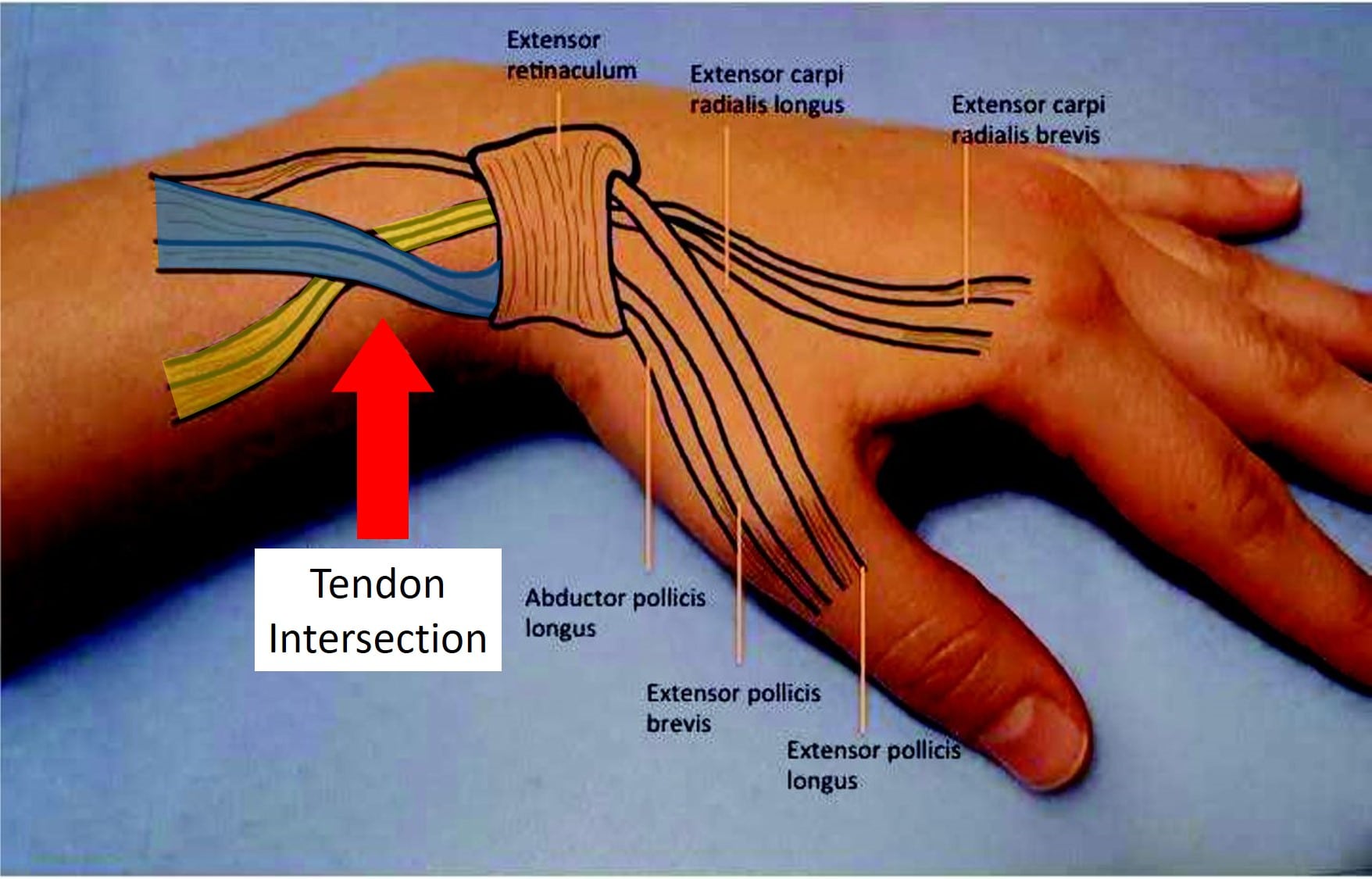What is Intersection Syndrome?
Intersection syndrome is a diagnosis that’s given to patients with a painful condition of the forearm and wrist. What causes this problem? How is it diagnosed? Can it be treated? If so, how?
What is Intersection Syndrome?
Intersection syndrome is defined by pain on the back thumb side of the wrist. This can occur in people who use repeated wrist actions, such as weight lifters, downhill skiers, and activities involving rowing. The “intersection” is the area between two “compartments” in the wrist containing tendons.
Which Tendons?

The tendons on the thumb side of the wrist that extend the hand or move it towards the thumb (radially) are the ones commonly involved in intersection syndrome. As shown above, in blue and yellow, these tendons have names like Abductor Pollicis Longus (APL), Extensor Pollicis Brevis (EPB), Extensor Pollicis Longus (EPL), and Extensor Carpi Radialis Brevis (ECRB). As shown above, the yellow two tendons in one compartment cross over the blue tendons in another compartment, and that spot represents the “Intersection”.
How is Intersection Syndrome Diagnosed?
The diagnosis of intersection syndrome is usually a diagnosis based on a clinical exam. In addition, musculoskeletal ultrasound can easily confirm it by looking for swelling in the tendons of this area. MRI images may also be helpful. X-rays and CT scans will definitely not be helpful in making this diagnosis as these technologies can’t “see” tendons.
How is Intersection Syndrome Usually Treated?
The main treatment for intersection syndrome consists of rest, use of a thumb splint, and medications. Steroid injections may be tried as well, but these can harm the tendon tissue. Surgery for this problem is rare. In that procedure, the inflamed tendon sheath is removed from the problem tendons at the crossover point. The problem? There are no spare parts here, so that tendon sheath is required for the smooth operation of the tendons as this acts as the lubrication for motion. Hence removing that structure is rarely a good idea.
How Else Can You Treat Intersection Syndrome?
Find and Treat the Cause!
One of the problems with this diagnosis is that it’s really a description of where the pain or swelling is located rather than an actual diagnosis of the cause of the swelling. For example, you’ve lived your whole life with these tendons crossing over each other, why is this happening now? You may have increased the use of your wrists, but again, in your life, you’ve likely used them as much for other activities. So again, why now?
What are the actual causes of intersection syndrome? For example, the ligaments that hold the small carpal bones in the wrist may be damaged causing too much movement of those bones which irritates the tendons. Hence, the cause of the intersection syndrome is excessive motion in those bones. To fix that issue, you need to get precise injections to tighten those ligaments and prevent too much carpal motion.
Another possible cause could be irritated nerves in the neck. These spinal nerves power the muscles attached to these tendons. That nerve irritation leads to misfiring muscles which then leads to extra wear and tear on the tendons. So fixing this type of patient with intersection syndrome requires treating the neck, usually again with injections. See my video below for more information:
Treat the Tendons
Once we know the actual cause of the intersection syndrome and that issue is addressed, then the doctors can treat the tendons directly. Most of what I’ve described here is treated with precise ultrasound or x-ray guided platelet-rich plasma injections. This is a solution made from your own blood by concentrating the platelets which contain healing growth factors. This is also the treatment for your banged-up wrist tendons.
The upshot? Intersection syndrome can be painful, but it should resolve with rest. If it doesn’t go away on its own, realize that the key to healing it is usually not surgery, but diagnosing what’s causing the problem and then using your own blood platelets to ramp up natural healing.

If you have questions or comments about this blog post, please email us at [email protected]
NOTE: This blog post provides general information to help the reader better understand regenerative medicine, musculoskeletal health, and related subjects. All content provided in this blog, website, or any linked materials, including text, graphics, images, patient profiles, outcomes, and information, are not intended and should not be considered or used as a substitute for medical advice, diagnosis, or treatment. Please always consult with a professional and certified healthcare provider to discuss if a treatment is right for you.